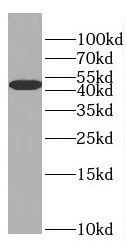Products
EIF4A3 antibody
| Synonyms: | Eukaryotic initiation factor 4A-III (eIF-4A-III antibody, eIF4A-III)|ATP-dependent RNA helicase DDX48|ATP-dependent RNA helicase eIF4A-3|DEAD box protein 48|Eukaryotic initiation factor 4A-like NUK-34|Eukaryotic translation initiation factor 4A isoform 3|Nuclear matrix protein 265 (NMP 265 antibody, hNMP 265)|Eukaryotic initiation factor 4A-III antibody, N-terminally processed|EIF4A3|DDX48|KIAA0111 antibody | ||
| Catalogue No.: | FNab02719 | Reactivity: | Human, Mouse, Rat |
| Host: | Rabbit | Tested Application: | ELISA, WB, IHC, IF, IP |
| Clonality: | polyclonal | Isotype: | IgG |
| Size | Price |
|---|---|
| 100µg | Inquiry |
- SPECIFICATIONS
- FIGURES
- CONDITIONS
- FAQS
- Product Name
- EIF4A3 antibody
- Catalogue No.
- FNab02719
- Size
- 100μg
- Form
- liquid
- Purification
- Immunogen affinity purified
- Purity
- ≥95% as determined by SDS-PAGE
- Clonality
- polyclonal
- Isotype
- IgG
- Storage
- PBS with 0.02% sodium azide and 50% glycerol pH 7.3, -20℃ for 12 months(Avoid repeated freeze / thaw cycles.)
- Immunogen
- eukaryotic translation initiation factor 4A, isoform 3
- Alternative Names
- Eukaryotic initiation factor 4A-III (eIF-4A-III antibody, eIF4A-III)|ATP-dependent RNA helicase DDX48|ATP-dependent RNA helicase eIF4A-3|DEAD box protein 48|Eukaryotic initiation factor 4A-like NUK-34|Eukaryotic translation initiation factor 4A isoform 3|Nuclear matrix protein 265 (NMP 265 antibody, hNMP 265)|Eukaryotic initiation factor 4A-III antibody, N-terminally processed|EIF4A3|DDX48|KIAA0111 antibody
- UniProt ID
- P38919
- Observed MW
- 47 kDa
- Tested Applications
- ELISA, WB, IHC, IF, IP
- Recommended dilution
- WB: 1:500-1:2000; IP: 1:200-1:1000; IHC: 1:20-1:200; IF: 1:20-1:200
 A549 cells were subjected to SDS PAGE followed by western blot with FNab02719(EIF4A3 antibody) at dilution of 1:600
A549 cells were subjected to SDS PAGE followed by western blot with FNab02719(EIF4A3 antibody) at dilution of 1:600
 IP Result of anti-EIF4A3 (IP:FNab02719, 3ug; Detection:FNab02719 1:300) with HEK-293 cells lysate 2800ug.
IP Result of anti-EIF4A3 (IP:FNab02719, 3ug; Detection:FNab02719 1:300) with HEK-293 cells lysate 2800ug.
 Immunohistochemistry of paraffin-embedded human kidney using FNab02719(EIF4A3 antibody) at dilution of 1:100
Immunohistochemistry of paraffin-embedded human kidney using FNab02719(EIF4A3 antibody) at dilution of 1:100
- Background
- ATP-dependent RNA helicase. Core component of the splicing-dependent multiprotein exon junction complex(EJC) deposited at splice junctions on mRNAs. The EJC is a dynamic structure consisting of core proteins and several peripheral nuclear and cytoplasmic associated factors that join the complex only transiently either during EJC assembly or during subsequent mRNA metabolism. The EJC marks the position of the exon-exon junction in the mature mRNA for the gene expression machinery and the core components remain bound to spliced mRNAs throughout all stages of mRNA metabolism thereby influencing downstream processes including nuclear mRNA export, subcellular mRNA localization, translation efficiency and nonsense-mediated mRNA decay(NMD). Its RNA-dependent ATPase and RNA-helicase activities are induced by CASC3, but abolished in presence of the MAGOH-RBM8A heterodimer, thereby trapping the ATP-bound EJC core onto spliced mRNA in a stable conformation. The inhibition of ATPase activity by the MAGOH-RBM8A heterodimer increases the RNA-binding affinity of the EJC. Involved in translational enhancement of spliced mRNAs after formation of the 80S ribosome complex. Binds spliced mRNA in sequence-independent manner, 20-24 nucleotides upstream of mRNA exon-exon junctions. Shows higher affinity for single-stranded RNA in an ATP-bound core EJC complex than after the ATP is hydrolyzed. Involved in the splicing modulation of BCL2L1/Bcl-X(and probably other apoptotic genes); specifically inhibits formation of proapoptotic isoforms such as Bcl-X(S); the function is different from the established EJC assembly. Involved in craniofacial development.
How many times can antibodies be recycled?
First, usually it's not suggested to recycle antibodies. After use, buffer system of antibodies has changed. The storage condition of recycled antibodies for different customers also varies. Thus, the performance efficiency of recycled antibodies can’t be guaranteed. Besides, FineTest ever conducted the antibody recycling assay. Assay results show recycling times of different antibodies also varies. Usually, higher antibody titer allows more repeated use. Customers can determine based on experimental requirements.
Notes: After incubation, we recycle rest antibodies to centrifuge tube and store at 4℃. High titer antibodies can be stored for a minimum of one week. Reuse about three times.
What are components of FineTest antibody buffer?
Components of FineTest antibody buffer are usually PBS with proclin300 or sodium azide, BSA, 50% glycerol. Common preservative is proclin300 or sodium azide, which is widely applied in the lab and industry.
How about the storage temperature and duration of FineTest antibodies?
Most antibodies are stored at -20℃. Directly-labeled flow cytometry antibodies should be stored at 2 - 8℃. The shelf life is one year. If after sales issues for purchased antibodies appear, return or replacement is available. Usually, antibodies can be still used after the one-year warranty. We can offer technical support services.
Is dilution required for FineTest antibodies? What’s the dilute solution?
Directly-labeled flow cytometry antibodies are ready-to-use without dilution. Other antibodies are usually concentrated. Follow the dilution ratio suggested in the manual. Dilute solution for different experiments also varies. Common antibody dilution buffers are acceptable(e.g. PBST, TBST, antibody blocking buffer).
How to retrieve antibodies for immunohistochemistry?
Common retrieval buffers: Tris-EDTA Buffer(pH 9.0); Citrate Buffer(pH 6.0)
Heat induced antibody retrieval:
Method 1: Water-bath heating: Put the beaker with retrieval buffer and slide in the boiling water bath. Keep the boiling state for 15min. Naturally cool to room temperature;
Method 2: Microwave retrieval: Put the beaker with retrieval buffer and slide in the microwave oven. Heat at high power for 5min, Switch OFF for 3min, Heat at medium power for 5min. Naturally cool to room temperature.
How to choose secondary antibodies?
(1) Secondary antibodies react with primary antibodies. Thus, secondary antibodies should be against host species of primary antibodies. E.g. If the primary antibody is derived from rabbit, the relevant secondary antibody should be against rabbit. E.g. goat anti rabbit or donkey anti rabbit.
(2) Choose secondary antibody conjugates according to the experimental type, e.g. ELISA, WB, IHC etc. Common enzyme conjugated secondary antibodies are labelled by HRP, AP etc. Fluorescin or dye labelled secondary antibodies are applied in immunofluorescence and flow cytometry(e.g. FITC, Cy3).
